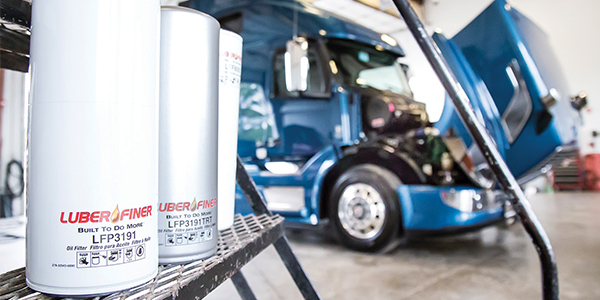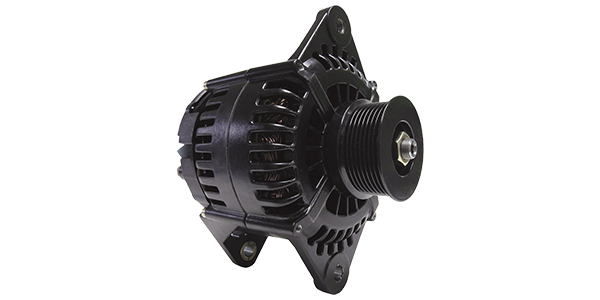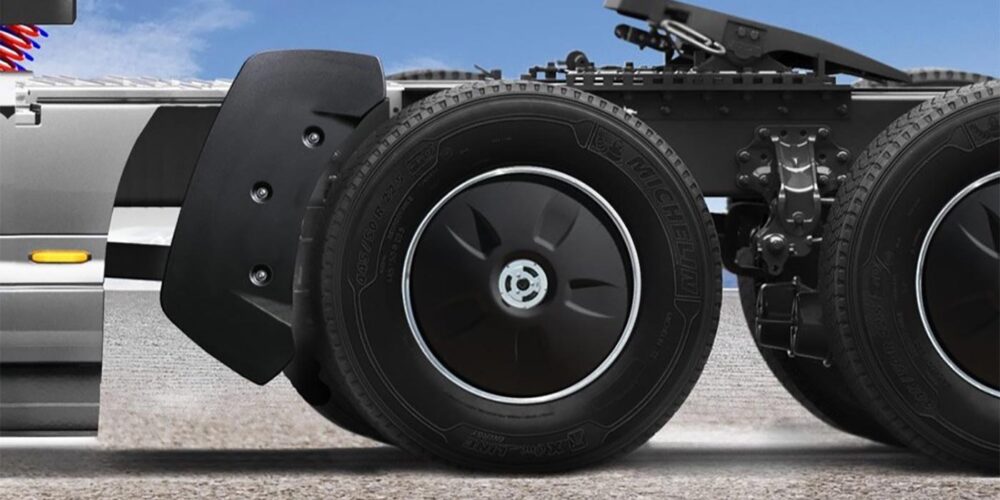Engine oil
A growing trend when it comes to engine oil is that many fleets are employing extended oil drain intervals for their trucks. This can be a time- and cost-saving practice, but only if your trucks are in an application that supports extended oil drain intervals. If it does end up being a smart move to go with extended oil drain intervals, know that your filtration system can handle it.
“Oil filters are the primary filter type that can deliver extended filter replacement intervals,” says Layne Gobrogge, director of heavy-duty marketing for Luber-finer. “Technological advances in filter media, specifically moving from conventional to synthetic materials, have increased the efficiency and capacity of oil filters considerably. By providing 99% efficiency and one-and-a-half times the filtering capacity of the leading cellulose filters, extended life oil filters made with 100% synthetic media can provide engine protection over a longer time period.
“The structure of modern filters has also improved to coincide with extended change intervals,” Gobrogge continues. “Elements such as heavy-duty seamless steel shells that provide unequaled burst and pulse-fatigue strength, extra-strength spiral cores that resist high-pressure surges, and durable vibration-resistant gaskets that provide a positive seal all contribute to a filter’s ability to deliver engine protection for a longer period of time.”
There are also oil filters available that provide a controlled release of a highly concentrated liquid conditioning additive into an engine’s oil over 40,000 miles to help combat the buildup of harmful acids.
“Longer intervals mean more hot/cold cycles, vibration and overall life needed,” says Donald Chilton, director of product management for Wix Filters. “We have to make sure the media, surface area and sealing materials can stand the longer intervals. These three parts are monitored and adjusted as needed.”
So what else do fleets need to keep an eye on when it comes to engine oil filtration?
One thing to look out for is contamination. Chilton says that oil breakdown is the main source of contamination in modern engines.
“You must know the oil life, and you can check it easily with an oil analysis kit,” he advises. “Always use a premium level oil filter from a reputable supplier with quality oil to keep your fleet running strong.”
According to Luber-finer’s Gobrogge, there is a major misconception about oil filtration right now: Many fleet managers falsely believe that they must use combination filters that utilize both bypass media and venturi technology or risk voiding their engine’s warranty. Gobrogge chalks this up to “confusing manufacturer warranty language and a misrepresentation of recently developed filter technologies.
“This misconception has prevented many of them from achieving the highest levels of oil filter capacity and efficiency by using full flow filters,” Gobrogge explains. “When used in accordance with OEM warranty-prescribed replacement intervals, full flow oil filters will not void original equipment warranty requirements. Full flow technology has been proven to outperform combination bypass filters in particulate removal efficiency and capacity, and offers limited oil restriction and more media area compared to combination filters.”
When it comes to warranties, be sure to double-check the details with your engine OEM.
Turbochargers
The turbocharger is a vital piece of the engine puzzle, as it enables the power and efficiency that fleets depend on by using the waste heat energy from combustion.
If you are in need of replacement turbochargers and are looking into reman or aftermarket turbos, you can have confidence in their quality, the manufacturers say.
“Fleets can expect the same quality as new,” Thomas Miles, manager of sales and marketing for the North American turbo aftermarket with BorgWarner, says of reman turbochargers. “Reman turbochargers are typically backed up by a same-as-new turbo warranty. Each remanufactured turbocharger is re-engineered to incorporate the most current product upgrades and refinements.”
Miles notes that BorgWarner is an OE provider of turbos as well, so they are familiar with the expectations and needs of fleets.
“PurePower maps their turbos to closely match the original equipment using very expensive hot cells, providing the customer confidence that the turbo will operate with like new performance,” says Phil Vince, program manager for fuel and turbo systems with PurePower Technologies.
Vince credits the company’s durability tests that validate the turbo design, and the company’s use of hot gas stands, vehicle tests, and engine dynamometers “to ensure the most efficient, powerful and durable operation of each turbocharger.” The durability tests, he says, are necessary because some applications push the turbo harder than others do, so it has to be ready for all possibilities.
Turbocharger maintenance
As with all truck equipment, a strong, well-prepared maintenance program is vital to keeping your turbos in optimal shape.
“The truck OEMs do a great job in designing the turbo operation to meet a wide range of operating characteristics,” PurePower’s Vince says, “but fleet owners may not require all the range of operation for their specific fleet task. Turbocharger flexibility is a great assistance in discovering potential efficiency improvements over different operation profiles. Like all machines, a robust and focused maintenance program will provide greater uptime and lower operation costs. These maintenance programs should be customized around the operation characteristics of the vehicle.”
According to the manufacturers, the highest percentage of turbocharger failures is caused by oil lag, lack of oil flow or contaminants in the oil.
“Just like blood for our bodies, engine oil sustains a turbo,” PurePower’s Vince says. “It keeps the turbo’s bearings from seizing. It is also the best diagnosis tool for potential turbo trouble. When completing oil changes, take oil samples and send to an oil analysis service. The report on the oil should identify potential contamination of heavy metals that will wear the turbo bearings. It should also identify diesel fuel dilution of engine oil, from injectors that are leaking, which removes the lubrication properties of the oil.”
The second-highest percentage of turbocharger failures is due to foreign objects entering the compressor and turbine wheels. These include, dust, sand and internal engine parts.
“An engine, through the turbo, consumes a lot of fresh air— almost 3 cu. ft. every second,” Vince explains. “Any particles in that air will be pulled through the tight clearances between the blades and housings and damage them permanently. Large objects 0.1 in. in diameter or bigger can destroy a turbo in seconds. Always invest in the best levels of air filtration recommended by the engine OE. Replace these filters regularly to make sure they are working effectively.”
In the event that service is needed, BorgWarner’s Miles strongly advises determining the exact cause of the turbo’s failure, the importance of which, he says, cannot be overstated.
“Frequently, a failed turbocharger is replaced with little or no thought given to the cause of the failure,” Miles says. “This results in a recurrence of the failure, which results in extra downtime and expense.”
The assessment of what went wrong, Miles adds, should be made at the time of the failure and before a replacement turbo is installed.
Starters & alternators
As with turbochargers, the manufacturers of starters and alternators say that aftermarket starters and alternators meet OEM specifications and quality standards.
So what does the fleet need to know?
“The best way to keep your starters and alternators working productively and your fleets running efficiently is to start looking and thinking about your starters and alternators as part of an entire electrical system,” advises Jonathan Smith, assistant director of aftermarket sales and marketing with Prestolite Electric. “We recommend frequently testing the system and its cables. Watch for voltage drop, make sure your alternator is large enough for the demands of the vehicle and its use, and test your batteries to make sure you’re not always ‘low voltage’ starting.”
Smith advises frequently running voltage drop tests along your electrical system cabling to confirm that they are in spec, and making sure that the cabling throughout the electrical system is spec’d correctly for the truck and use.
“We recommend making sure the cable is the correct size; that all connection points are clean so you get the maximum output of the starter or alternator; and that the system, including the battery, is clean,” he adds.
Rod Spangler, application engineering manager with BorgWarner, provides the following checklist for fleets to keep to:
- Always keep electrical connections at all points of the charging and starting system clean and free from contamination.
- Inspect belts for wear and cracks, and check for proper tension to keep the alternator charging efficiently.
- Verify that the charging system is properly maintained. Batteries that are not at the proper state of charge can cause hard starting and possible starter damage.
Additionally, Spangler notes that BorgWarner provides support and training to fleets that install Delco Remy Genuine Products such as starters and alternators. On-site and online electrical system troubleshooting training is available, as well as a full library of Tech Tip videos that address several common issues.
















